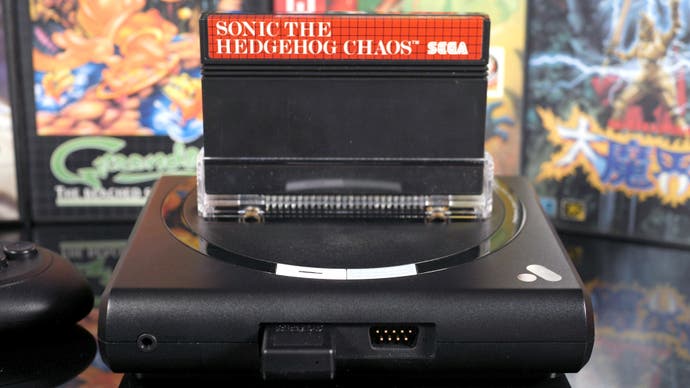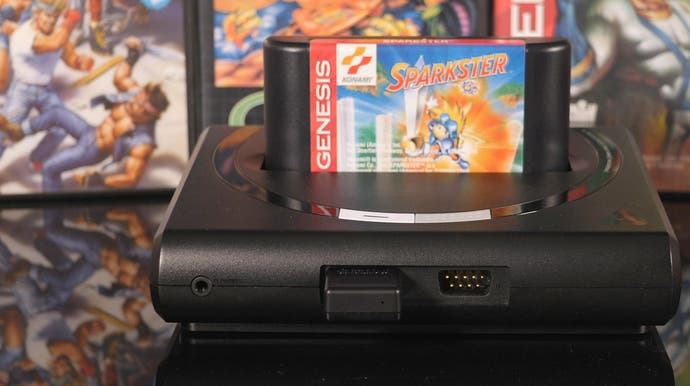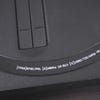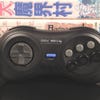Analogue Mega Sg review: the best Mega Drive clone for flat panel TVs
The ultimate retro Sega console.
In what has become somewhat of a tradition at this point, boutique console manufacturer Analogue has returned with a new machine focused on Sega's eight and 16-bit legacy - the Master System and Mega Drive/Genesis. The new Mega Sg is a beautiful piece of hardware designed to play Sega games with optimum compatibility while delivering pristine visual results on a modern flat panel display.
The Mega Drive or Genesis is Sega's most successful console. With over 30 million units sold worldwide, it was arguably the first system to challenge Nintendo's dominance in the marketplace and with a wide selection of superb games, it's not difficult to see why. From Sonic, Shinobi and Streets of Rage to third-party classics like Rocket Knight, Gunstar Heroes and Thunder Force 4, it was the place to be for fast-paced action.
For those wanting to revisit the system today with their original cartridge library, however, options haven't always been great with low quality clone systems, such as those from AT Games, failing to accurately deliver the original experience, sometimes with absolutely shocking results. The Mega Sg aims for absolute accuracy, using an FPGA (Field Programmable Gate Array) to accurately recreate the original silicon. While Mega Drive is the main focus of this review, an adapter in the box supports the 8-bit Master System, while further adapters are incoming to allow for compatibility with Game Gear, SG-1000 and more.
The Sg also includes an edge connector on the bottom of the unit allowing it to connect to a Mega CD - both the Model 1 and 2 versions are supported. There's a small spacer pad included so the Sg sits comfortably in place, and it does work as intended but the small size of the unit means that it doesn't look great visually - the Sg is just too small for the hulking CD unit. Unfortunately though, there is no 32X support. This is partially due to the digital nature of the video output - the 32X relies on a passthrough where video from the Mega Drive is passed into the 32X and then out to the TV from there.
The Mega Sg ships in four colour variants and retails for $189 - and just like its SNES-emulating Super Nt, the system uses a plastic shell as opposed to the anodised aluminum of the much more expensive Nt Mini. The design of the console resembles a miniaturised version of the original console and although support for original controllers and cartridges is included, video output is via HDMI, and it's powered by USB. A two-prong style multi-voltage power adapter is included in the box but any adapter that can provide five volts at two amps will work. There's also an SD card slot, but right now at least, game ROMs do not work using this slot.
As for controller options, the Mega Sg works fine with any original 9-pin controller but 8BitDo also has a pair of pads available alongside this unit - the m30 and m30 2.4g. The difference? The m30 is a Bluetooth pad that works with other Bluetooth capable systems while the 2.4g uses a different wireless connection enabling lower latency which, according to RetroRGB, comes in around 3.6ms versus 21ms of the Bluetooth pad. It's remarkably comfortable and a recommended accessory for both the Sg and original Megadrive consoles.
Overall, it's a beautiful machine with excellent built quality, thick plastic and a design that evokes the original machine but while the shell is beautiful, it's what's inside that truly counts. Like the Super Nt and Nt Mini, Analogue has partnered with Kevin "Kevtris" Horton to handle system engineering duties. It's a great little package with a solid design, slick interface, a focus on accuracy and tons of adjustable options.
So, why does the world need a $189 retro Sega system? These days, there are plenty of options available for playing Mega Drive games: you can use an original system connected to a CRT, for starters, or you can pair that system with something like the Open Source Scan Converter enabling a sharp image on a modern flat panel display. Emulation is another go-to with many popular software emulators available today including the cycle-accurate Blastem and the dated but still popular Kega Fusion among many others. And yes, you can use your Raspberry Pi - the solution that emulation fans will make sure you never ever forget exists.
One of the most difficult aspects of using original hardware comes from variation in consoles - while mods can correct many faults, stock systems are often of variable quality and have different limitations to consider. The Model 1 system I use in many tests, for instance, features exceptional audio but exhibits vertical lines, or jail bars, which I haven't taken the time to correct. Meanwhile, emulation has various accuracy issues and potential lag problems - at its best, the Mega Sg is as fast and responsive as original hardware.
Kicking off with some of the best games on the system, first impressions are strong. Contra: The Hard Corps runs like a dream and sounds beautiful, Rocket Knight Adventures offers a pixel-perfect match for the original machine while the Sonic games, of course, run brilliantly (and yes, Sonic and Knuckles' lock-on technology functions as it should). Virtua Racing, with the Sega Virtua Processor chip, runs correctly as well but this is the only retail Mega Drive game I know of that utilises a separate chip within the cart itself. Even newer, modern games, like Tanglewood, function correctly. The developer, Matt Phillips, even provided a demo he used to test the game on different hardware configurations - this demo basically runs through the entire game testing various states that occur during normal play. It works flawlessly on the Mega Sg. The introduction to Red Zone also displays correctly as does the video introduction sequence featured in Sonic 3D Blast.
Another game worth mentioning is The Adventures of Batman & Robin - this is, without a doubt, one of the most technically impressive games available for the system. Created by a small company known as Clockwork Tortoise with lead programmer John O'Brien steering the direction of the game's visuals, Batman and Robin really pushes the system hardware. Lots of per-scanline effects are used to create the illusion of 3D graphics and it rarely slows down. It also features a few challenging segments to emulate properly - but the Mega Sg doesn't miss a beat. I even put the hardware through its paces on the most offerings from the demo scene, which take the system into places it never reached back in the day. As you'll see on the video embedded on this page, the Mega Sg delivers where emulators can't. Even Blast Processing works!
Usually, when people think of poor Megadrive emulation, it's usually the audio that stands out as most important and where many devices and emulators - even retro products by Sega itself - can fall short. In poor devices, like the At Games range, sound fidelity is severely degraded compared to any flavor of original hardware. This is, perhaps, where the Sg is most impressive then. The sound quality is superb, and it's configurable too.

Out of the box, the Sg sounds brighter and clearer than Model 1 output, but options such as the low-pass filter and ladder effect adjustment allow users to tune audio playback as they like for best results. As for other options, there is also the inclusion of a high-quality mode, which utilises the full 14-bit output instead of truncating to 9-bit like original hardware, allowing increased precision which should theoretically improve sound. There's also an option to enable cartridge and CD audio which is required when using the Sega CD and it has its own volume control. The only issue here is that, enabling this setting results in a slight low-hum when no audio is passing through so I recommend using this only when external audio is required.
Overall, though, the sound implementation here is fascinating. The impression is of a perfect implementation of hardware that was imperfect in its original form. Thus, it takes some effort to dial in settings that mimic the original imperfections. Out of the box, it sounds far too clean but there are enough options available here to get very close to real hardware.
I also tested Mega CD support, and again, the Mega Sg works perfectly... almost. I played through a wide range of games on the system including simple Mega Drive ports such as Earthworm Jim Special Edition. This game features the same visuals as the original release but with additional stages and a CD audio soundtrack. there were more ambitious titles as well. Silpheed features a complex blend of pre-rendered, low-colour 3D and real-time objects manipulated by the hardware. The way in which the backgrounds are encoded using so few colours allows them to display full-screen without typical artefacts observed in CD games on this system. It, of course, runs flawlessly on the Mega Sg.
Batman Returns works great too displaying the full capabilities of the system as does Soul Star from Core. FMV games function as they should - you can 'enjoy' Slam City with Scottie Pippen all day long, if you desire or switch over to Make my Video INXS. This is one area, though, where the system's colour palette limitations become obvious - video playback is remarkably grainy when displayed in this manner. The playback of redbook audio is, of course, perfect. I did run into one problem, however - Chuck Rock won't boot. You get the logo screens then, during the intro, a black screen with sound effects and no way to proceed.
But it's Road Rash which brings me to another feature of the Mega Sg worth discussing - dither blending. The idea here is that the system seeks out either vertical stripes of alternating colours or a checkerboard pattern and then attempts to average the colours together. The idea is to simulate the way colours bleed together when using composite video, but without the additional side effects of this low quality video solution.

This feature is very effective but has its limitations. In the case of Road Rash, enabling dither blending helps clean up the noisy artwork to create a smoother looking game overall. It's not perfect but it's a nice compromise. I found that this technique is most effective when displaying large, flat colours such as those in Virtua Racing. Here, dithering is used throughout the game and blending these shapes results in cleaner, smooth colours instead. The only downside is that edges of these surfaces still showcase dithering artefacts.
A slider is available to adjust the way in which this feature works, which can be useful - at the lowest setting, checkerboard patterns tend to receive the most attention while the highest setting seems better for vertical stripes like waterfalls in the Sonic titles. As for fully sorting out stippling in Mega CD games? No chance. patterns are just too irregular, reducing the effectiveness of the technique. It still helps somewhat but videos remain similarly grainy.
Another cool feature is border masking, perhaps one of my favourite options. Normally, in most games, background colour zero displays within the overscan region. The system outputs 240 lines of resolution but typically, games only draw 224 pixels, so colour zero appears as a border around the game. The predictable size of this border, however, means that cropping them is simple and relegated to this basic toggle.
The settings elsewhere are similarly impressive. HDMI output supports 480p, 720p and 1080p at both 60Hz and 50Hz - so the select range of PAL-exclusive titles optimised for 50Hz also look and play exactly as they should. I typically use the 1080p mode myself but if you want to use scanlines, 720p tends to produce more desirable results. Speaking of scanlines, there are normal and hybrid scanline options. The normal produces solid, even, black bars while hybrid attempts to adjust intensity based on surrounding colour information to simulate how it might work on a CRT.
There are a lot of scaling options as well - I recommend using the advanced mode which allows you to dial in settings to suit your preference. You can use the start button to cycle through presets allowing you to target different pixel and aspect ratios. I prefer these settings but only when using the horizontal and vertical interpolation. These options basically apply a subtle filter to the image to avoid improper scaling artefacts such as shimmering. It slightly reduces sharpness but still looks great on a typical TV. If you want ultra-sharp pixels, though, you'll want to disable these features and use either 4 or 5x height while setting horizontal to square pixels.
The rest of the features available under scalers focus on basic image alteration options you might find in an emulator. The buffer mode then determines system speed - the default zero delay setting runs games at a straight 60Hz as opposed to 59.92Hz. This results in perfect frame persistence but introduces a tiny bit of latency and a subtle change in gameplay speed. For normal play, it's impossible to notice, I feel, but it's there. Fully buffered runs at the original 59.92Hz but as this is displayed within 60Hz output, you get a duplicate frame every 13 frames or so - and to my eyes, it's bothersome. The same goes for single buffer which is the lowest latency option but you get torn frames at regular intervals. I'd suggest sticking with zero delay.
One other option available on the main menu, is the option to play Ultracore - a game developed by DICE back in the 90s originally under the title Hardcore. It was cancelled at the time but was recently recovered and is included as a bonus with the Mega Sg. It looks rather impressive, I must say - a good example of late-gen Mega Drive title with impressive animation and richly detailed backdrops.
The focus in this review has been on the Mega Drive side of things, but inside every Mega Sg box is an adapter that allows you to use Master System titles with the system. They run really nicely too. You can pause games from the controller instead of the system, speed is correct and the games I've tested work as expected. Another major feature of the Sg when playing Master System games lies in its ability to crop the image. Master System games typically render within a smaller pixel resolution resulting in large, coloured borders. The size of these borders varies on a per game basis, and the Mega Sg offers granular control here. The ability to play Master System games is a really nice bonus and I'm interested in checking out the other cartridge adapters down the line.
So that's where we stand then. The Mega Sg is a great way to enjoy classic Sega games on a modern display, and it's one of the best options available. While I still prefer cozying up in front of a CRT, it's great to have a fully digital solution with pristine video and audio output. Of course, there are a lot of other great solutions out there as well including high-quality cycle accurate emulators, so it's up to you to decide, but if you're looking for a beautifully designed piece of kit with precision playback and a whole host of customisation options, the Mega Sg is a superb option for retro Sega action on a modern flatpanel display.









